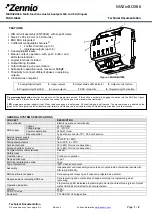
AUBER INSTRUMENTS
WWW.AUBERINS.COM
2018.08
P7/14
heater. The more foams there is, the easier it is to boil over. The vigorous the
boil is, the easy it is to boil over. To preventing the boiling over, operator should
skim the foam out and reduce the power as the temperature approaching the
boiling. Since the heater power and liquid volume varies between each
application, we suggest the bAST to be set at least 5 degree (Fahrenheit) below
the boiling point for the first time use. As you getting familiar with your system,
you can change this setting to higher or lower. The bOUT is the power used
during initial heating phase. The unit is in percent of power. It should be set to
100% unless you have a very powerful heater with very small amount of liquid.
The bOUT setting does not limit the power regulation range for boiling phase.
If
you don’t need to use this feature, set bAST
to 0, so this controller will
work as a manual mode controller over the entire temperature range.
Note 8:
Timer and event settings (boil mode): nE, bot1 ~ bot9
A timer event is defined as an action of adding an ingredient at a specific time
point during the wort boiling process. An event timer starts from the moment that
the ingredient is being added to the wort; it stops when the wort-boiling process
comes to an end. There can be multiple events during the wort-boiling process.
Each event should have a different starting time point, but they all end at the
same time, which is when the boiling process ends.
To start activate the timer event, you need to 1) change the timer status from
“stop” to “run” by pressing Key A momentarily. 2) the reading temperature must
be higher than bTSP (section 6.3, note 9). When the timer starts, the top display
will show the reading temperature and total the remaining time (before the end
of last event) alternately. The temperature and time display can be easily
differentiated with their appearance. The temperature reading has two or three
digits. For example, 212 degrees will be displayed as “212”. The timer display
has four digits with fl
ashing colon in the middle. For example, “01:20” for 1 hour
20 minutes. The bottom display will show the power output percentage and
current step number (e.g. P-1 for step 1) alternately.
Please see Figure 9 for a schematic diagram showing the relationship between
multiple events and the alarm relay status.
nE,
total number of timer events.
An event can be associated with an activity
such has adding hops or special ingredients. Each event has its own timer.
nE
can be set to a number from 1 to 9. The built-in buzzer will be triggered at the
beginning of all events except the first event, and at the end of the entire boiling
process. So
nE
is equal to the total number of times you want the buzzer to ring.
You can also set the external relay synchronized with the built-in buzzer (section
6.4.2, note 12). For example, if you only add one hop at the very beginning of
the boiling process, and add another hop in the middle of boiling, which is
considered as the second event, you need to set nE = 2, and the buzzer will go
off when the second even starts.
Event timer
: botX (i.e. bot1, bot2, bot3, …, bo
tX),
the time duration of each
event, where
X
is the event number (1 ~ 9).
X
is decided by parameter
nE
. Time
duration of an event,
botX
, is the boiling time of an ingredient to be added to the
boiling wort.
bot1
is the first event timer which starts from the moment that the
first ingredient is added until the end of boiling,
bot2
is the second event timer
which starts when the second ingredient is added until the end of boiling, and so
on. The buzzer will be triggered at the beginning of all event timers (
bot1
,
bot2
, …,
bot9
). The buzzer will be also triggered when all the event timers are
ended.
An event timer that starts later should be no longer then the event timers that
start earlier, i.e.,
bot1
≥
bot2
≥
bot3
≥ …≥
botX
. When an event timer is equal
to its prior event timer, this event timer will be ignored. For example, if you set
bot1
=
bot2
, timer
bot2
will be ignored.
Example: If the first ingredient (bot1) needs 60 minutes, the second ingredient
(bot2) needs 10 minutes and third ingredient (bot3) needs 1 minutes of boil, you
set Bot1 = 1:00, Bot2 = 00:10, Bot3 = 00:01. Assuming the timer will start at 0
minute (add first ingredient here). 50th minute from the beginning, controller will
beep and let you add second ingredient. 59th minute from the beginning,
controller will beep again to remind you it is the time to add the third ingredient.
Figure 9. A schematic diagram of how the event timers and built-in buzzer work
(nE = 3).
Note 9: Boiling mode timer function: tF, btSP, bEO
tF
. The
timer event function (for boil mode)
is controlled by a master
parameter
tF
. When it is set to
ON
, the timer event function for boiling mode is
enabled. When
tF
is set to
OFF
, the timer function for boiling mode is disabled.
When timer function is enabled, the timer counting will be started by
timer start
temperature, btSP
. When reading temperature reaches timer start temperature,
the timer starts to count, and the controller will generate three short beeps. After
timer started counting, it will continue even if the temperature drops below this
start temperature. The timer can be reset to start from beginning again. To reset
the timer, press the knob momentarily, the display will show
rSt
on top and
“n”
at the bottom, rotate the dial clockwise will change the bottom display to
“
y
”
.
Press the knob again to reset the timer.
When time counting ends, the controller will generate eight long beeps. Both
displays will flash
“
End
”
alternately. After timer ends, the power output can be
configured either to continue heating, or shut off. It is controlled by the parameter
called
ending options for boiling mode, bEO
. Set it to
ON
for continue heating,
set it to
OFF
to turn off the output.
goto
boil
Knob
bast
200
Knob
bout
100
Knob
ne
3
Knob
bot1
01
:
00
Knob
bot2
00
:
20
Knob
80
100
Knob
Press
Press
Press
Press
Press
Press
Press
Boil acceleration
set temp.
Boil
acceleration
output power
Total numbers of
timer events
Event 1 timer
Event 2 timer
Event 3 timer
tf
on
Boil timer
start temp.
Knob
beo
off
Knob
ad
10
Knob
btsp
208
Knob
Press
Press
Press
Press
Alarm duration
for boil mode
Boil
ending option
Timer function
for boil mode
bot3
00
:
01
End
Figure 10. Flow chart for boiling mode settings































